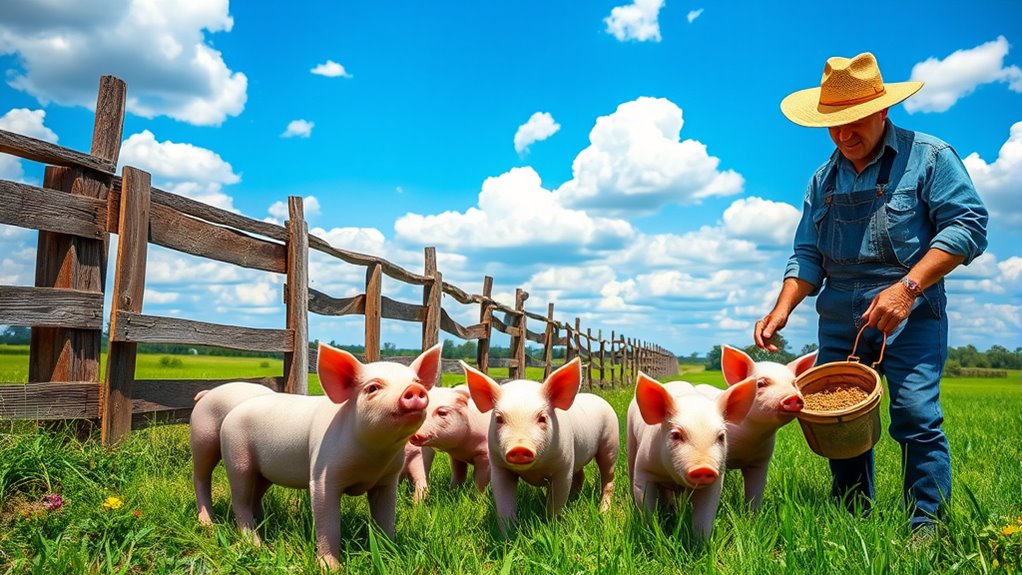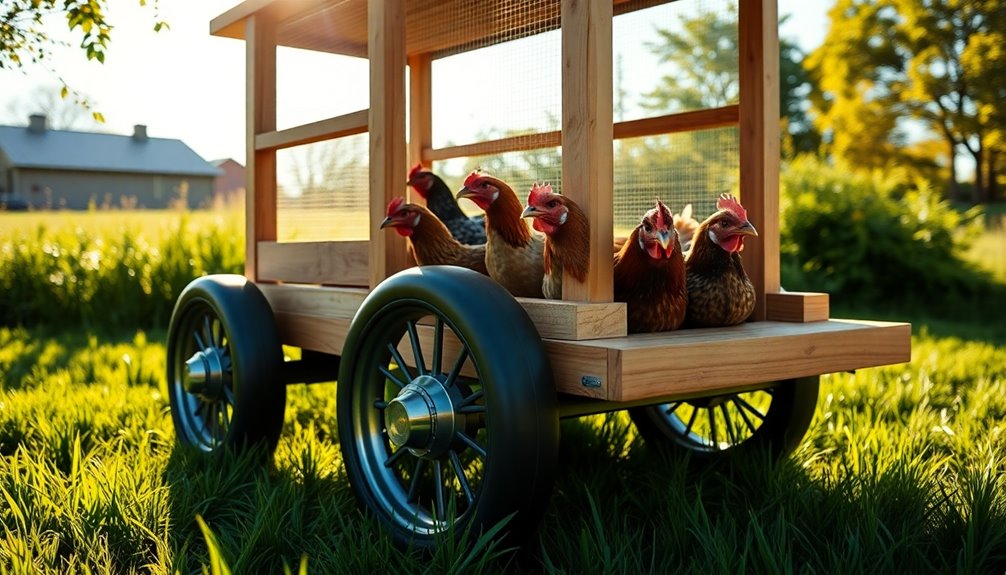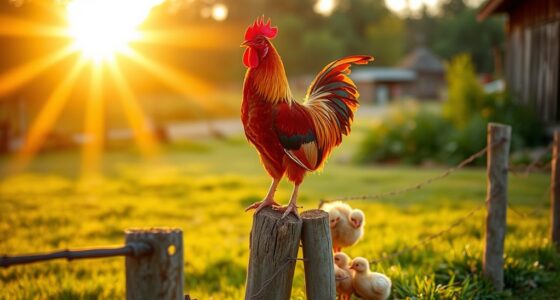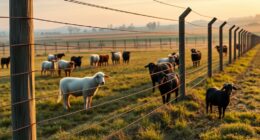When raising pigs, start with heritage breeds like the American Guinea Hog for great flavor and manageable growth. You'll need sturdy fencing, a clean water source, and proper shelter to keep them safe and comfortable. Each pig needs at least 50 square feet of space and quality bedding. Feed them a balanced diet with grain and kitchen scraps for healthy growth. If you're curious about managing their health and butchering, there's much more to explore!
Key Takeaways
- Choose a heritage breed, like the American Guinea Hog, for better genetics and exceptional meat quality suited for small farms.
- Ensure sturdy fencing and a clean, sheltered environment with at least 50 square feet per pig for their well-being.
- Provide a balanced diet with grain-based feed and access to fresh water, supplemented with safe kitchen scraps and foraging.
- Plan to butcher pigs at six to seven months old, targeting a market weight of 180-250 pounds for optimal meat quality.
- Consider hiring an experienced butcher to ensure quality results and effective meat cutting during the butchering process.
Understanding Pig Breeds
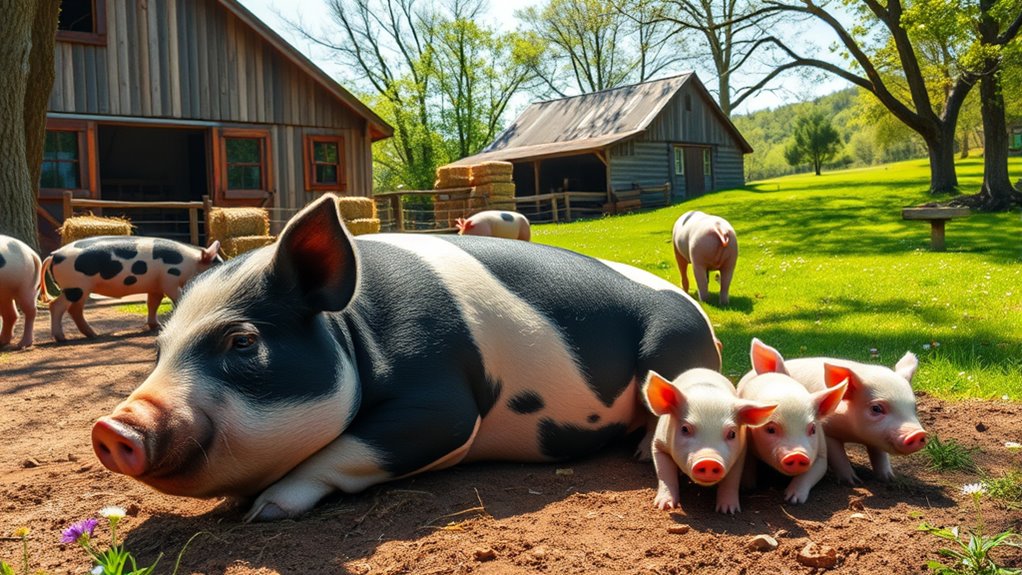
When you're diving into the world of pig farming, understanding the different breeds is essential.
Heritage breeds, like the American Guinea Hog, are perfect for small farms and beginners. These pigs boast strong genetics, exceptional meat quality, and a calm temperament, making them easier to handle.
Heritage breeds like the American Guinea Hog are ideal for beginners, offering strong genetics and exceptional meat quality.
Unlike modern production breeds, heritage pigs grow at a slower pace but offer a superior flavor profile and high-quality meat, thanks to their foraging abilities.
When raising a pig, consider factors like growth rate and temperament to guarantee you choose the best fit for your homestead goals.
With the right breed, you can enjoy a rewarding experience in pig farming while producing delicious, tender meat for your family.
Essential Supplies for Raising Pigs
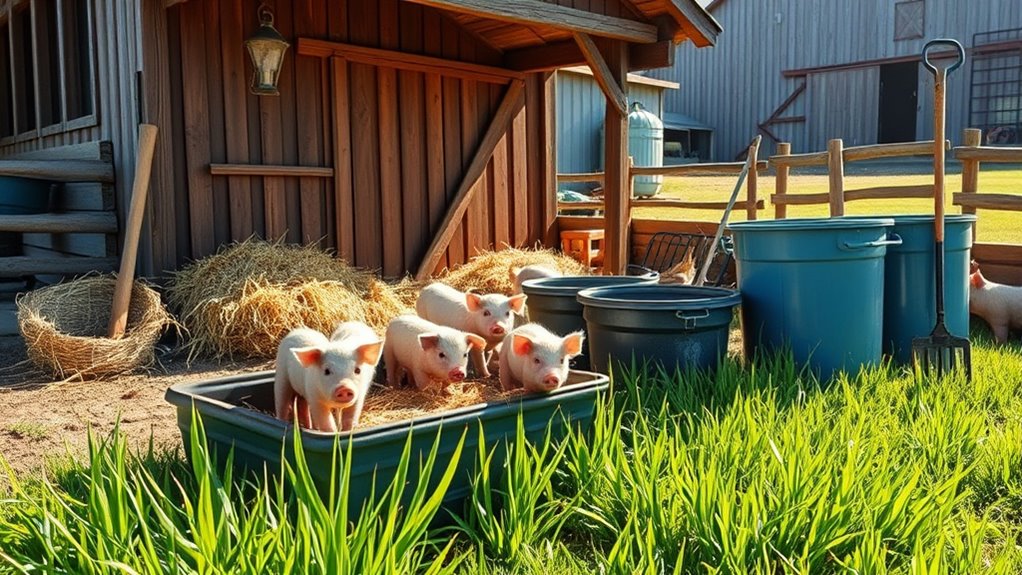
To successfully raise pigs, you'll need to gather some essential supplies that guarantee their health and well-being.
Start with sturdy fencing, like electric wire or hog panels, to keep your pigs safe and prevent escapes. You'll also need a reliable source of clean water, as pigs drink 2 to 4 gallons daily; consider DIY pig waterers for ease.
Shelter is important for protection against weather and predators, so build one with a partial roof for shade. Maintaining cleanliness in the pigpen is essential, so provide about eight inches of bedding, like wood chips, for comfort and temperature regulation.
Be prepared for initial setup costs, which can range from $0 to $5000, depending on your choices. Finally, don't forget quality pig feed!
Space and Shelter Requirements
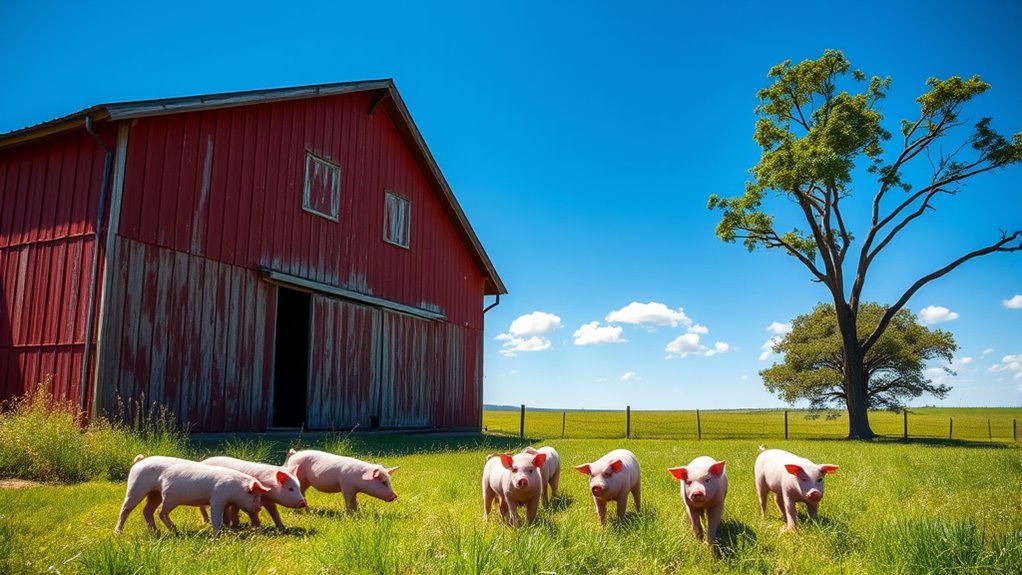
Ensuring your pigs have enough space and appropriate shelter is essential for their overall health and happiness.
Providing ample space and proper shelter for your pigs is crucial for their well-being and contentment.
To create a comfortable home for your pigs, consider the following:
- Each pig needs a minimum of 50 square feet of space in a fenced-in area.
- A sturdy, hog-tight fence with a bottom board prevents digging and keeps them secure.
- Shelter should have a partial roof and three sides for protection against weather and predators.
- Provide bedding, like wood chips or straw, about eight inches deep for temperature regulation and cleanliness.
Feeding Practices for Healthy Growth
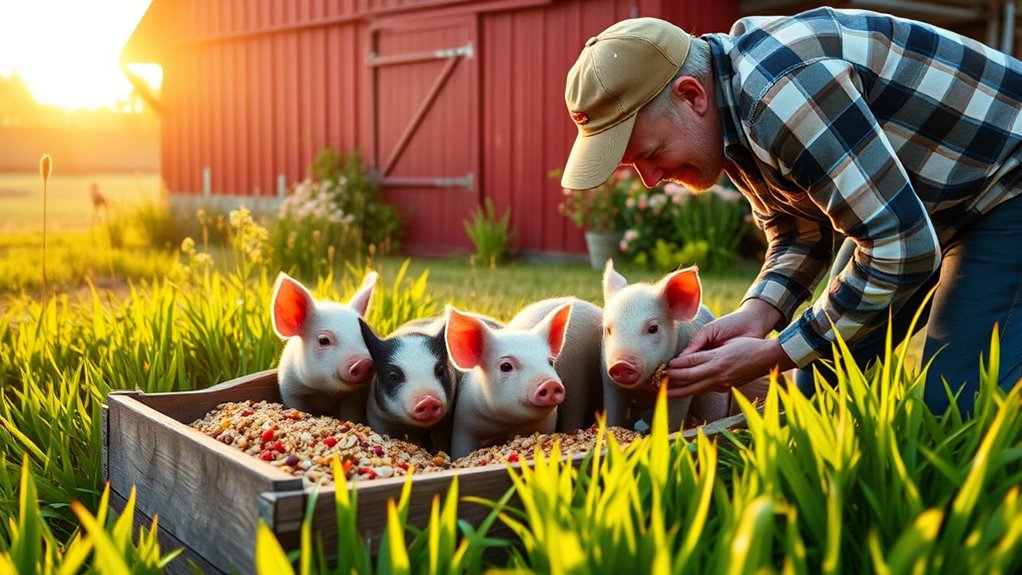
Feeding your pigs a balanced diet is essential for their healthy growth.
You can enhance their nutrition by supplementing with kitchen scraps and allowing them to forage, which not only reduces feed costs but also promotes a varied diet.
Keeping an eye on their weight and adjusting their feed accordingly will help you achieve ideal growth rates.
Balanced Nutritional Diet
A balanced nutritional diet is essential for pigs' healthy growth and development. To guarantee that your pigs thrive, focus on their specific nutritional needs throughout their growth stages.
- Provide grain-based feed with 16% protein for piglets and 14% for pigs around 125 lbs.
- Regularly monitor their water intake, ensuring access to 2 to 4 gallons of fresh, clean water daily.
- Adjust feed amounts based on your pigs' size and health, using demand feeding wisely to manage costs.
- Supplement their diet with safe kitchen scraps, fruits, and vegetables, while avoiding harmful foods like rhubarb leaves.
Supplementing With Kitchen Scraps
Kitchen scraps can be a fantastic way to enhance your pigs' diet while keeping costs down. Pigs eat a wide range of food, including fruits, vegetables, and leftover meats, making food scraps an excellent supplement to a pig's diet.
However, verify that all table scraps are fresh and free from mold to avoid healthy issues. While providing variety is beneficial, remember that their main diet should remain grain-based to meet their nutritional needs.
Monitor the overall diet carefully, adjusting the amount of kitchen scraps based on their growth stages and health requirements. This balance will help keep your pigs healthy and thriving while allowing them to enjoy their foraging instincts.
Foraging and Rooting Benefits
While pigs are often fed a grain-based diet, allowing them to forage and root in their environment can greatly enhance their health and development.
As omnivores, pigs can eat a diverse range of foods that not only reduce feed costs but also promote better nutrition.
Here are some benefits of foraging and rooting:
- Soil Aeration: Pigs naturally aerate the soil, improving pasture health.
- Weed Management: Their rooting behavior helps control weeds effectively.
- Varied Diet: Foraging allows pigs to access plants, seeds, and insects, enriching their diet.
- Improved Meat Quality: A diverse diet can enhance the flavor and health of the meat you produce.
Incorporating these practices can greatly benefit your pigs and lead to healthier growth.
Managing Health and Well-Being
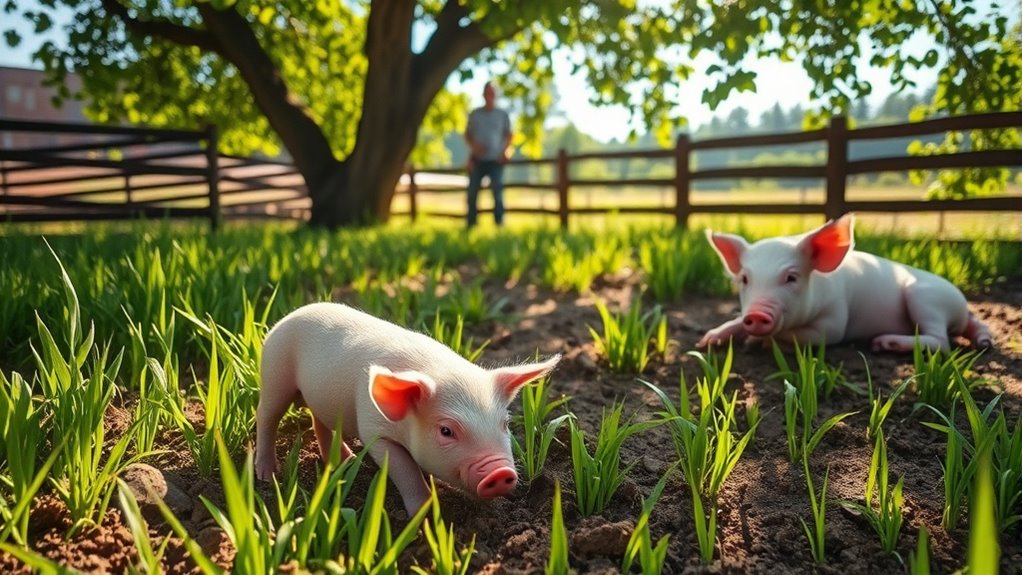
To keep your pigs healthy and thriving, regularly monitoring them for signs of stress or illness is vital. Early detection helps guarantee effective treatment and overall herd health.
Maintain good hygiene by keeping living areas clean and well-maintained, checking water and feed supplies frequently. Pigs need constant access to fresh water, consuming 2 to 4 gallons daily, so monitor their intake to prevent dehydration, especially in hot weather.
Consult a veterinarian for de-worming protocols, as internal parasites can pose significant health risks; treatment every four to six weeks is imperative. Additionally, consider vaccines and regular health checks to support their well-being.
Using approved pesticides can help control lice and mites, further safeguarding your pigs' health.
Butchering Considerations
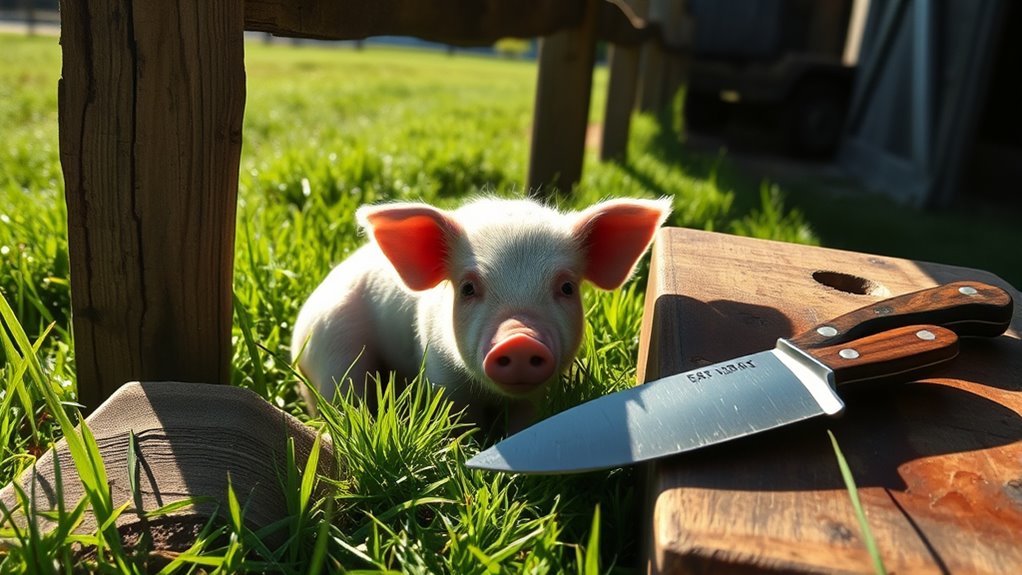
When it comes to butchering your pigs, timing is essential.
You'll want to aim for six to seven months old, ideally in the fall, to make the process smoother.
Understanding the steps involved—from killing to processing—will help you feel more confident and prepared.
Timing for Butchering
Choosing the right time to butcher your pigs is essential for achieving the best meat quality and yield. Typically, you should consider butchering when they're six to seven months old, ideally reaching a market weight of 180-250 pounds. Heritage pigs are especially sensitive to timing, as butchering them at the right moment maximizes their superior meat quality.
- Butcher in the fall to ease winter feeding challenges
- Monitor growth rates, as timing varies depending on the breed
- Aim for ideal meat quality by evaluating the pig's condition
- Plan for a butchering process that generally takes about three days
Butchering Process Steps
After you've determined the right time to butcher your pigs, it's important to understand the steps involved in the butchering process.
Typically, this involves three main steps: killing and hanging the pig, skinning, and cutting the meat into various sections.
For heritage pigs, aim for a live weight of 180-250 lbs to achieve ideal meat quality after processing. Proper timing, usually at six to seven months old in the fall, is vital to avoid winter challenges.
Many farmers opt to hire an experienced butcher to guarantee quality results and to master cutting the meat effectively.
Frequently Asked Questions
How Many Pigs Should I Start With?
When you're thinking about starting with pigs, it's best to begin with at least two. Pigs are social animals, and having a companion will help them thrive.
You'll want to guarantee they've enough space, aiming for about 50 square feet per pig. Starting with feeder pigs around two months old is ideal, allowing you time to raise them before butchering.
Always check your local regulations to confirm what's allowed on your property.
How Do You Raise a Pig for Beginners?
To raise a pig, start with feeder pigs around two months old.
Make certain you have a secure pen with at least 50 square feet per pig and sturdy fencing.
Feed them a balanced diet, including pre-mixed feed and kitchen scraps, while avoiding harmful foods.
Monitor their health regularly and maintain clean living conditions.
Consider rotating pastures to keep them healthy and allow for foraging.
Always consult a vet for vaccinations and check-ups.
How Many Acres Do You Need to Raise Pigs?
To raise pigs effectively, you'll need at least one to two acres for a small herd. This space allows pigs to forage, root, and roam, which promotes their health and natural behaviors.
While you can manage pigs on smaller plots, having more land reduces odors and helps maintain better soil health.
Always check local ordinances to verify you're compliant with regulations regarding the number of pigs you can keep on your property.
What Is the Best Pig Breed for Beginners?
When you're stepping into the world of pig farming, the choice of breed can make or break your experience.
You'll want a breed that's manageable yet rewarding. Heritage breeds like the American Guinea Hog or Gloucestershire Old Spots are your best bet.
They're docile, hardy, and thrive in various environments. Plus, their smaller size and flavorful meat make them ideal for beginners just like you, ready to commence on this exciting journey.
Conclusion
Raising pigs can be like nurturing a garden; with the right care, they'll thrive and bring you bountiful rewards. As you tend to their needs—providing shelter, food, and health—you'll watch them grow strong, like vibrant flowers reaching for the sun. Embrace the challenges and joys, and remember that patience and dedication will yield a harvest of satisfaction. Your journey in pig raising isn't just about livestock; it's about cultivating life and fostering connections that last.

